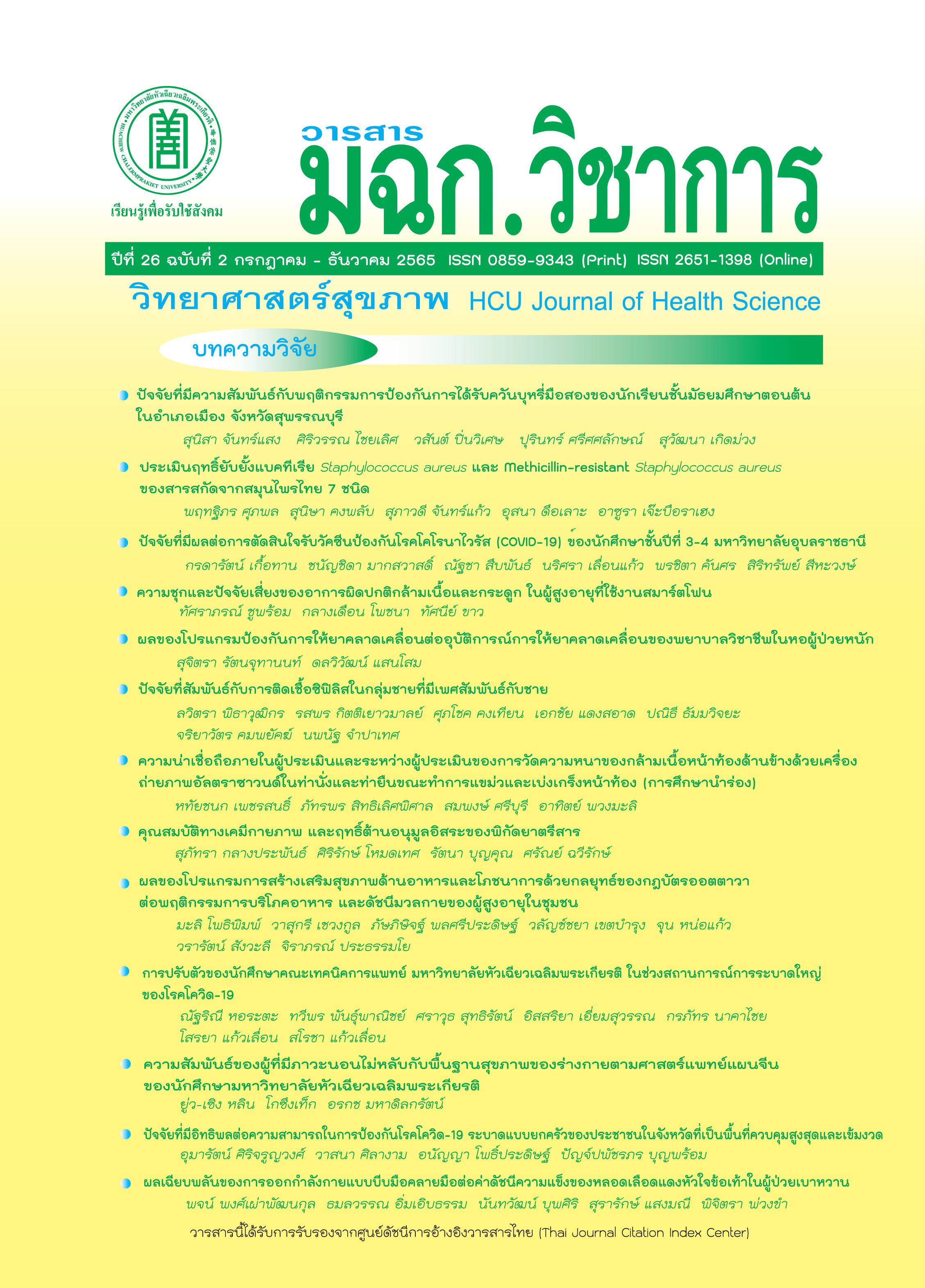Evaluation of Antibacterial Activity against Staphylococcus aureus and Methicillin-resistant Staphylococcus aureus of Extracts from Seven Thai Herbal Plants
Keywords:
Herbal plant, Crude Extract, Antibacterial activityAbstract
This research aims to study the antibacterial activity (Staphylococcus aureus (SA) and Methicillin-resistant Staphylococcus aureus (MRSA) of extracts from seven Thai herbal plants (Citrus aurantifolia, Cymbopogon citratus, Citrus hystrix, Curcuma longa, Centella asiatica, Senna siamea and Carissa carandas). Each plant was extracted with methanol and hexane. All crude extracts were evaluated for their antibacterial activity by using a colorimetric broth microdilution test. The minimum inhibitory concentration (MIC) and minimum bactericidal concentration (MBC) were evaluated. The results showed that extract from Curcuma longa was the most active against S. aureus ATCC25923 with MIC 0.025 mg/ml and MBC 0.2 mg/ml and MRSA with MIC 0.5 mg/ml and MBC 1.6 mg/ml. On the other hand, hexane extracts from Citrus aurantifolia, Cymbopogon citratus and Citrus hystrix gave the moderate antibacterial activity with MIC 0.1 0.5 and MBC 0.8 mg/ml, respectively. whereas, the remaining extract showed the lowest antibacterial efficiency with MIC concentration range of 3.2-12.8 mg/ml and MBC concentration range of 12.8 – 20 mg/ml. These results show that crude extracts from some Thai herbal plants are interesting source of active metabolites for future application.
Downloads
References
นิตยา เขียวสะอาด, อัศวิน ดาดูเคล. โรคติดเชื้อในโรงพยาบาลและสถาณการณ์การดื้อยา. ว. การแพทย์และวิทยาศาสตร์สุขภาพ 2558;22(1):81-92.
จิราภรณ์ บุราคร, เรือนแก้ว ประพฤติ. ผลของสารสกัดสมุนไพรพื้นบ้านไทยจำนวน 7 ชนิดต่อการยับยั้งเชื้อแบคทีเรีย. ว. การแพทย์แผนไทยและการแพทย์ทางเลือก 2555;10(1):11-22.
นิภาพรรณ มะลิซ้อน. แบคทีเรียดื้อยา: อดีตและปัจจุบัน. ว. อาหารและยา 2558;22(3):4-6.
ภโวทัย พาสนาโสภณ. สารออกฤทธิ์ในสมุนไพร. ว. วิทยาลัยพยาบาลพระปกเกล้า จันทบุรี 2559;27(1):120-31.
วันเพ็ญ เพ็ชรจันทร์, ธีรพร กงบังเกิด. การศึกษาประสิทธิภาพของสารสกัดจากพืชในการยับยั้งแบคทีเรียก่อโรคในอาหารและการประยุกต์ใช้. ว. วิทยาศาสตร์ 2551;9(1-2):26-36.
วิภาวรรณ นีละพงษ์, บุษบา ผลโยธิน, วันเซ็ง สิทธิกิจโยธิน. การสกัดสารสำคัญจากสมุนไพรไทย: แบบผงแห้งและแบบสกัด. ว. วิชาการพระจอมเกล้าพระนครเหนือ 2562;29(1):157-66.
Nimrat S, Soodsawaeng P, Vuthiphandchai V. Chemical composition and antibacterial activity of ethanol extract of lemon grass (Cymbopogon citratus) on pathogenic bacteria: A review. J of Science and Technology Ubon Ratchathani University 2018;20(3):20-8.
ตยาคี พลล้ำ, รสจรินทร์ แซ่โซ, จุฑาวดี ฤทธิสอน, ธนภัทร สืบราศรี, อรอุมา จันทร์เสถียร. ฤทธิ์ต้านแบคทีเรียของสารสกัดจากใบสาบเสือและใบบัวบกต่อเชื้อสแตฟฟิโลคอคคัส ออเรียส. ว. วิชาการมหาวิทยาลัยอีสเทิร์นเอเชีย ฉบับวิทยาศาสตร์และเทคโนโลยี 2565;16(1):99-105.
ณัฐริกา ขันเงิน, อรุณลักษณ์ โชตินาครินทร์, มนตรา ศรีษะแย้ม. การศึกษาสารสกัดจากลูกหว้าและมะม่วงหาวมะนาวโห่ในการยับยั้งจุลินทรีย์ก่อโรค. ว. วิทยาศาสตร์เกษตร 2562;50(1):262-7.
จันทนา กาญจน์กมล. ฤทธิ์ต้านแบคทีเรีย ฤทธิ์ต้านอนุมูลอิสระและฤทธิ์ต้านเซลล์มะเร็งของสารสกัดฝาง. ว. วิทยาศาสตร์และเทคโนโลยี (ววท) 2564;29(2):307-17.
สุกัญญา จันทร์สุนะ, ลลิตา เจริญทรัพย์, เยาวพา จิระเกียรติกุล, พรชัย หาระโคตร. ผลของอุณหภูมิและระยะเวลาการอบแห้งต่อปริมาณสารต้านอนุมูลอิสระและความสามารถในการยับยั้งอนุมูลอิสระของใบบัวบก. วารสารวิทยาศาสตร์และเทคโนโลยี 2563;28(12):2261-72.
วีรภัทร วิโนทพรรษ์. การประยุกต์ใช้เอนไซม์ในรูปอิสระและรูปตรึงสำหรับการสกัดสารธรรมชาติจากพืช. ว.รไทยไภษัชยนิพนธ์ 2557;9(1):57-70.
Aibinu I, Adenipekun T, Adelowotan T, Ogunsanya T, Odugbemi T. Evaluation of the antimicrobial properties of different parts of Citrus aurantifolia (Lime fruit) as used locally. African J of Traditional, Complementary and Alternative 2007;4(2):185-90.
สิริแข พงษ์สวัสดิ์, ทรงพล จำดิษฐ์. ฤทธิ์ต้านแบคทีเรียของเปลือกผลไม้บางชนิดต่อ Methicillin-resistant Staphylococcus aureus. ว. วิทยาศาสตร์และเทคโนโลยี มทร. ธัญบุรี 2558;5(1):63-9.
ปวีณา วัดบัว, คุณานนท์ อั้นเต้ง, ณัฐวุฒิ วงษ์วิชา, ธนพล วัฒนาธร, อภิรักษ์ อินทชิต, นิจิโรจน์ จรัสบวรพันธ์. การยับยั้งแบคทีเรียของสารสกัดหยาบจากพืชสมุนไพรที่พบบริเวณโรงเรียนนายร้อยพระจุลจอมเกล้าต่อเชื้อแบคทีเรียก่อให้เกิดกลิ่นเท้า. ว. วิชาการโรงเรียนนายร้อยพระจุลจอมเกล้า 2559;14(1):131-6.
วนิดา ไทรชมพู, ภรณ์ประภา อ่วมนุช, กัลยา แสงฉวี, ปิลันธนา เลิศสถิตธนกร. การพัฒนาเม็ดบีดส์จากน้ำมันหอมระเหยที่มีฤทธิ์ต้านเชื้อ Methicillin-resistant Staphylococcus aureus. ว. วิทยาศาสตร์และเทคโนโลยี มหาวิทยาลัยปทุมธานี 2563;1(1):24-34.
วันเพ็ญ เพ็ชรจันทร์, ธีรพร กงบังเกิด. การศึกษาประสิทธิภาพของสารสกัดจากพืชในการยับยั้งแบคทีเรียก่อโรคในอาหารและการประยุกต์ใช้. ว. วิทยาศาสตร์และสิ่งแวดล้อม 2551;9(1-2):26-36.
มณฑล วิสุทธิ. สูตรผสมของสารสกัดจากพืชสำหรับยับยั้งแบคทีเรียก่อโรคบางชนิด. ว. วิทยาศาสตร์และเทคโนโลยี มทร. ธัญบุรี 2562;9(2):125-35.
นุศวดี พจนานุกิจ, สมใจ ขจรชีพพันธุ์งาม. เจลสมุนไพรสำหรับยับยั้งแบคทีเรียที่ทำให้เกิดสิว. ว. วิทยาศาสตร์ลาดกระบัง. 2553;19(2):47-58.
ณัฐริกา ขันเงิน, อรุณลักษณ์ โชตินาครินทร์, มนตรา ศรีษะแย้ม. การศึกษาสารสกัดจากลูกหว้าและมะม่วงหาวมะนาวโห่ในการยับยั้งจุลินทรีย์ก่อโรค. ว. วิทยาศาสตร์เกษตร 2562;50(1):262-7.
นพดล หงษ์สุวรรณ, แคทรียา สุทธานุช, ดวงกมล ศักดิ์เลิศสกุล. การศึกษาองค์ประกอบทางเคมีเบื้องต้น คุณค่าทางโภชนาการและฤทธิ์ต้านเชื้อแบคทีเรียของผลมะม่วงไม่รู้หาวมะนาวไม่รู้โห่ (Carissa caradas). ใน: The 7th Annual Northeast Pharmacy Research Conference; วันที่7-8 เดือนมีนาคม พศ 2558; ณ ขอนแก่น: มหาวิทยาลัย; 2558. หน้า7-13.
Prakatthagomol W, Sirithunyalug J, Okonogi S. Comparison of antibacterial activity against food-borne bacteria of Alpinia galangal, Curcuma longa, and Zingiber cassumunar. Chiang Mai University J of Natural Sciences 2012;11(2):177-86.
Teow S-Y, Liew K, Ali SA, Khoo AS-B, Peh. S-C Antibacterial action of curcumin against Staphylococcus aureus: A brief review. J of Tropical Medicine 2016;2853045:1-10.
Gupta A, Mahajan S, Sharma R. Evaluation of antimicrobial activity of Curcuma longa rhizome extract against Staphylococcus aureus. Biotechnology Reports 2015;6:51-5.
Downloads
Published
How to Cite
Issue
Section
License
Copyright (c) 2022 HCU Journal

This work is licensed under a Creative Commons Attribution-NonCommercial-NoDerivatives 4.0 International License.
บทความที่ได้รับการตีพิมพ์เป็นลิขสิทธิ์ของวารสารวิทยาศาสตร์สุขภาพและสุขภาวะ
ข้อความที่ปรากฏในบทความแต่ละเรื่องในวารสารวิชาการเล่มนี้เป็นความคิดเห็นส่วนตัวของผู้เขียนแต่ละท่านไม่เกี่ยวข้องกับมหาวิทยาลัยหัวเฉียวเฉลิมพระเกียรติ และคณาจารย์ท่านอื่นๆในมหาวิทยาลัยฯ แต่อย่างใด ความรับผิดชอบองค์ประกอบทั้งหมดของบทความแต่ละเรื่องเป็นของผู้เขียนแต่ละท่าน หากมีความผิดพลาดใดๆ ผู้เขียนแต่ละท่านจะรับผิดชอบบทความของตนเองแต่ผู้เดียว




